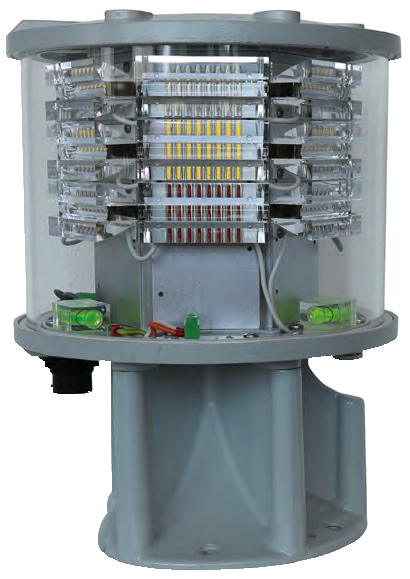aircraft warning lights are high-intensity lighting devices that are placed on structures such as tall buildings, towers, and antennas to warn pilots of their presence and help prevent collisions. The lights are typically red or white and flash in a specific pattern to make them more noticeable to pilots flying at night or in low visibility conditions. These lights are very important for aviation safety and are used around the world to ensure that pilots can see potential obstacles in their flight path.
Click on this link to buy Aircraft Warning Light.
Why are aircraft warning lights red?
Aircraft warning lights are typically red because the color red has a longer wavelength than other colors, such as blue or green. This makes it easier for pilots to see the lights from a greater distance, especially in low visibility conditions like fog or haze.
Additionally, the use of red lights for warning purposes is a long-standing convention in many cultures, and is often associated with danger and caution. Red is also used in other warning devices, such as emergency brake lights on vehicles, for similar reasons.
Overall, the choice of red for aircraft warning lights is based on practical considerations of visibility and safety, as well as cultural and historical factors related to the use of color for warning and cautionary purposes.
At what height do buildings need aircraft warning lights?
The height at which a building requires aircraft warning lights depends on a variety of factors, including its location, surrounding terrain, and proximity to airports and flight paths. In the United States, the Federal Aviation Administration (FAA) regulates these requirements and provides guidelines for determining when structures need to be marked with warning lights.
Generally speaking, buildings that exceed a certain height above ground level will require aircraft warning lights. According to FAA regulations, buildings that are taller than 200 feet (61 meters) above ground level generally require warning lights, as do any other structures that could pose a hazard to air navigation. However, this threshold may be lower in certain areas, such as near airports or in particularly hilly or mountainous terrain.
It’s important to note that local regulations may vary depending on the country or region in question, so it’s always best to consult with aviation authorities and follow local guidelines to ensure compliance with safety regulations.
Types
There are several types of aircraft warning systems that are used to ensure flight safety. Some of the most common types include:
- Ground Proximity Warning System (GPWS): This system is designed to alert pilots when their plane is in danger of colliding with the ground. It uses radar altimeters to detect the plane’s altitude and warns the pilot if the plane is descending too rapidly.
- Traffic Collision Avoidance System (TCAS): This system alerts pilots when there is another aircraft nearby that is on a collision course. It uses radio signals to communicate with other planes in the area and advises the pilot on how to avoid a potential collision.
- Enhanced Ground Proximity Warning System (EGPWS): This is an advanced version of the GPWS, which provides additional warnings to pilots if they are flying close to terrain or obstacles such as mountains, towers or power lines.
- Weather Radar: These systems use radar to detect weather patterns and help pilots avoid dangerous conditions such as turbulence, icing, and thunderstorms.
- Flight Data Recorders (FDRs): These recorders collect and store data about a plane’s performance during flight, including altitude, speed, direction, and other critical indicators. In case of a crash or emergency landing, this data can be used to determine what went wrong and why.
These systems play a crucial role in maintaining aviation safety, and their applications have saved countless lives over the years. Pilots and air traffic controllers rely on these systems to prevent accidents and ensure smooth operations in complex airspace.
Environmental challenges affecting aircraft warning systems and solutions to mitigate them
Environmental challenges can have a significant impact on aircraft warning systems, potentially compromising their effectiveness and reliability. Here are some of the most common environmental challenges affecting these systems, along with some solutions to mitigate their impact:
- Weather: Adverse weather conditions such as heavy rain, snow or fog can interfere with radar and other sensors used in aircraft warning systems, reducing their accuracy and range. Installing advanced sensors and upgrading existing systems with weather-resistant materials can help mitigate these impacts.
- Electromagnetic Interference (EMI): EMI from electronic devices or nearby power lines can cause false alarms or disrupt communication between aircraft warning systems and flight crews. Shielding systems and using high-quality components that are less susceptible to EMI can help prevent these issues.
- Bird Strikes: Birds and other wildlife can collide with aircraft warning systems like radar and damage sensitive components. Regular maintenance and inspections, along with installing protective covers around sensitive areas, can help reduce the risk of bird strikes.
- Solar Flares: Solar flares can disrupt the operation of satellite-based aircraft warning systems, leading to communication errors and reduced accuracy. Advanced satellite technology and backup communication channels can help maintain reliable communication despite solar flares.
- Climate Change: Climate change can cause changes in weather patterns, which can have a direct impact on the performance of aircraft warning systems. Investing in research and development of more advanced sensors and technologies that can better withstand changing weather patterns can help mitigate the impact of climate change on aircraft warning systems.
By addressing these environmental challenges, we can ensure that aircraft warning systems remain effective and reliable, even as environmental conditions evolve. This will help us maintain aviation safety and prevent accidents in the years to come.
